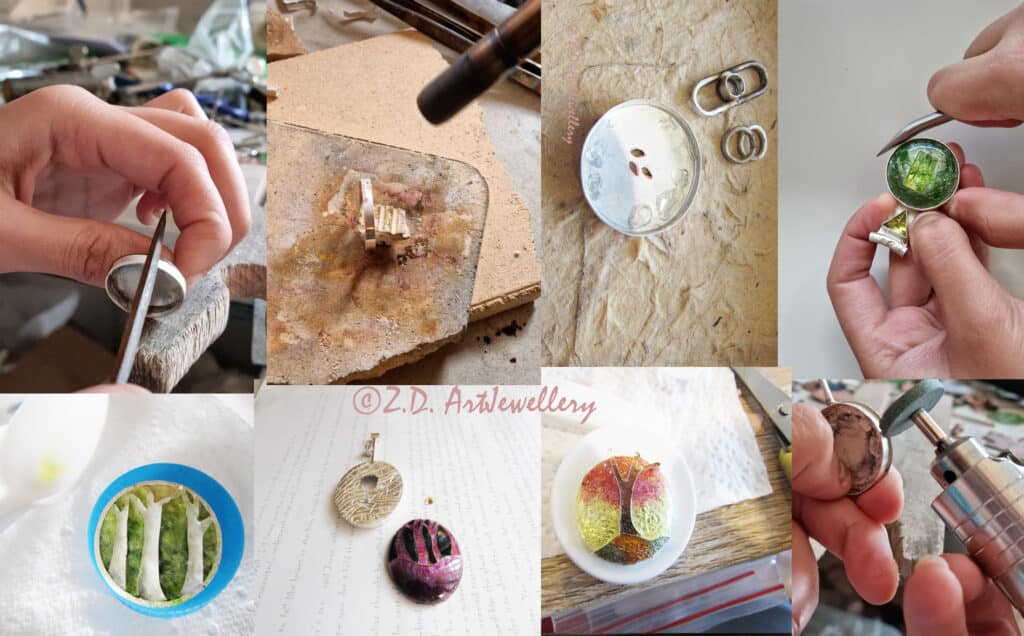

In this post, I want to write about slow fashion and slow jewellery as solutions for fashion industry. I write about our social responsibility to change our shopping behaviour. Also, I want to consider slow fashion and slow jewellery to potentially lead us towards sustainability. However, I need to explain the problem first!

Fast fashion is a business model in fashion industry that quickly mass- produce clothes and bring them into retail stores. Speeding up supply chain assist them to capture the most recent fashion trends. This process would not be possible without manufacturing cheap and low-quality garments. To maintain their exclusivity the brands destroy their unsold clothes . Of course, burning or sending the unsold clothes to landfill does not only happen in fast fashion brands. It is happening in luxury brands as well. They do this simply because they don’t want to sell their luxury merchandise for a cheaper price to people who can’t afford buying luxury goods!! Just imagine how much natural resources have been consumed to manufacture those clothes that are destroyed every year by brands. And also, we can not ignore how much this process can contribute to carbon emission and world climate change!
The fast fashion clothes that are sold also have a short lifespan and would quickly end up in landfill. They are made using cheap fabric, and they are not lasting at all. On the other hand, fashion trends become outdated fast. Hence, fast fashion buyers get rid of their clothes after few times wearing them. Obviously, Western consumerist culture contributes in the success of fast fashion industry! According to a research by LeVi’s brand, Australians wear almost half of what’s in their wardrobes

There is a very similar trend in jewellery fast fashion or fast jewellery! Of course, if you look at jewellery as art and not a category of fashion, the story is quite different! Fast fashion retailers offer jewellery along with clothes. Also, some specific fast jewellery brands have emerged in recent years. So, artistic timeless jewellery pieces have been replaced by this trendy cheap jewellery styles!
Like the low-quality fabric (usually plastic-based) used in fast fashion clothes, fast jewellery is made of low-quality materials. Some of them are actually plastic and glue! So, in addition to the fact that they are not eco-friendly, you can wear them only few times as there are not durable.
Some of them that are made from base metals like brass and zinc are usually plated using silver. This is usually to make them “imitation jewellery”. So they can copy latest celebrity fashion trends! As the silver layer is usually thin, it will be removed after awhile and the base metal would tarnish and leave a green residue. This can potentially create issue for people with allergies. Durability, colour and other properties of some base metals like copper and brass make them suitable options for affordable jewellery. So, here, I don’t mean the authentic and correct use of these metals in handcrafted jewellery. The issue is that styles of these fast jewellery become obsolete fast. And also, due to lower quality, they do not last long.
A study shows that over half of low‐cost jewellery ranks high for toxic chemicals such as heavy metals. The researchers tested some adults and children jewellery in US states. Besides, in recent years, some other materials have come in style to make jewellery. One of them is polymer clay options that are not typically biodegradable and recyclable. However, some of polymer clay brands have switched to safer and biodegradable materials. The other type of material is resin. Most resins are the result of crude oil and the refining process, which is not definitely eco-friendly. Again, there are some eco-friendly options. However, this type of jewellery also emerges based on trends and come and go in short cycles. People usually do not use resin or polymer clay jewellery for years like we used to in classic jewellery in good old times!!
It is estimated that 92 million tonnes of textiles waste are created each year, worldwide. So, let’s have a brief look on the environmental impacts of fashion industry. It is estimated that 10% of global greenhouse gas emissions is produced by fashion industry. And only textile manufacturing is blamed for 1.2 billion tonnes of greenhouse gases emission into atmosphere every year. On the other hand, manufacturing process require a huge amount of water. Hence, fashion industry is responsible for 20% of global waste water. As a result, we pay a huge cost for our consumerist culture!
Jewellery manufacturing industry has also environmental effects. As mentioned earlier, the manufacturers use synthetic materials to make fast jewellery that are not recyclable. In some cases, they use crude oil processing in their manufacturing process. That isspecifically adding to carbon emissions and pollution on earth.
Mining metals and precious stones damages the environment massively. However, in addition to the pollution created by mining process, we should also consider limitation of natural resources for mining.
Recycling is vital in having a more sustainable fashion and jewellery industry. The process of recycling and related technologies are not efficient in clothes industry at all. According to BBC report, just 12% of the material used for clothing is globally recycled. A major obstacle in recycling clothing is the variety of fabric and accessories used in clothes. The variation makes the process of sorting textiles into different fabric and material types difficult. On the other hand, fast fashion clothing have low quality and durability. So, they cannot usually reused as second-hand clothes. We should be aware that Many of the clothes we donate to charity end up dumped in landfill and create serious environmental issue on the other side of the world, usually low-income countries.
Recycling in jewellery made using classic materials is a more efficient process and quite possible. Metals are usually recyclable in even small scales. Currently, there are many bench jewelers who recycle metals specifically silver and gold in their studies. We can also reuse genstones. Hence, jewellers can separate gemstones and metal in damged jewellery pieces. They can melt metal and roll it into sheets and wires and reuse them in making another piece. They can also separate undamaged gemstones and set them in other pieces. Recycling is the key in making jewellery manufacturing sustainable.
Fortunately, the ethical issues of fashion industry have been highlighted in the last years and unfortunately, there is no significant improvement regarding these issues! In addition to the environmental problems discussed earlier, there are serious ethical concerns about exploitation of labour. Some of these issues are underpayment of workers, violations of labour rights, child labour, and mental and physical health of the models in a global scale.

Various forms of labour exploitation are also happening in the mining process of jewellery raw materials throughout the world. About 1 million children work in the mining industry worldwide. Mining of raw materials often occurs in low-income, developing countries. And in some of these countries poor working conditions, low wages and child labour are not penalized. This is also a cost they pay for endless consumerist culture in developed countries and their interest in maximizing their profit. That is the result of ignoring workers’ welfare by brands and manufacturers in developed countries for a long time.
Kate Fletcher, the design activist and author, has coined the term, “slow fashion” as opposite of fast fashion. Slow fashion is a movement towards a sustainable fashion industry. It will not be possible without changing the culture and philosophy behind shopping! The first step is definitely putting a brake on our overshopping and change our shopping behavior. Start thinking about quality of what we are buying and their manufacturing process! Always buy lasting clothes and accessories and use them for longer! Do a little research about the brand! Is this an ethical and sustainable brand? Do they pay their workers fair wages? Or they outsource their manufacturing to pay minimum wages to their labor? Usually the smaller local brands are more trustable. I have also seen that some slow fashion brands offer recycling service for their merchandise which is great!
That is important to keep asking and replace our consumer culture with a thoughtful slow shopping! If this transition happens, we remind the brands and manufacturers about their responsibilities other than making profit! We might remind them about their environmental, ethical and social responsibilities!
I am an independent designer and jeweller and when it comes to jewellery, I will definitely encourage slow jewellery! To purchase jewellery, choose any independent jeweler and maker who operates a small business. They put a lot of thought, time and energy into what they are making. These jewelleres usually buy their raw materials from local suppliers. They know what materials they are using to make a piece of jewellery for you. These jewellery pieces are lasting and personalized. Some of them are one of a kind! How different is the feeling of wearing something mass-produced and something that is exclusive to you?
As an artjeweller, I use recycled silver in all my works. I also try to research about the source of gemstones I am buying . But I should confess that it is not a successful research all the time. Retailers don’t know much about the mining and source of the stones! I hope we can change this!
I also love enamelling. And you should know that enamel pieces are very durable. There are some enamels in museums from 13th century! So, it is great if all of us begin thinking what we are supporting with our shopping! Are we supporting consumerist culture, fast fashion, labor exploitation and acceleration of climate change? Or we are supporting sustainability, small businesses, and environmental-friendly and fair manufacturing?
We use cookies to improve your experience on our site. By using our site, you consent to cookies.
Manage your cookie preferences below:
Essential cookies enable basic functions and are necessary for the proper function of the website.
These cookies are needed for adding comments on this website.
Stripe is a payment processing platform that enables businesses to accept online payments securely and efficiently.
Service URL: stripe.com (opens in a new window)
Statistics cookies collect information anonymously. This information helps us understand how visitors use our website.
Google Analytics is a powerful tool that tracks and analyzes website traffic for informed marketing decisions.
Service URL: policies.google.com (opens in a new window)
You can find more information in our Privacy Policy.